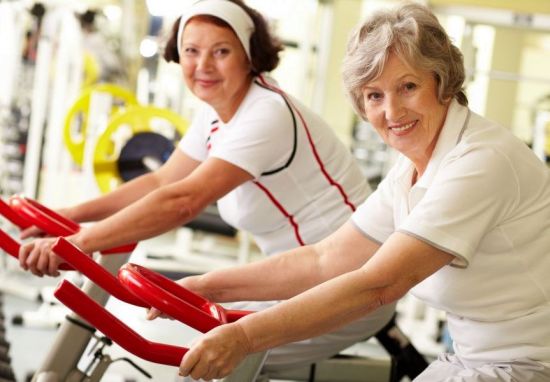Which is a lot of fun, but also has its drawbacks. Namely, lots of people like to share their opinions about how I look. Or more specifically, how my legs look. But not in a good way.
One day, I got fed up with all of the “someone skipped leg day” comments, and decided to do something about it.
To be clear, I’ve never been one to skip leg day. However, my history of knee injuries had made it difficult for me to train my lower body as often or as hard as I want to.
I struggled with patellar tendonitis from the ages of 14 to 21, and had four knee surgeries by the time I was 22. The last surgery actually ended my college football career. So throughout my 20s, I just decided to work around my past injuries and wear pants to cover up.
But not anymore.
Above are before-and-after photographs of my transformation. It’s no coincidence that I’m doing stepups in the images—they are staples in my leg-changing program.
When I first looked back at my old photos, the difference in my legs was shocking. What’s even more surprising? The change throughout my entire body.
Related: Normal-Sized Guys Who Are Freakishly Strong Tell You How They Did It
Even though I purposefully trained my upper body less in order to allow my legs to catch up faster, I was leaner and more muscular up top.
And that’s a true testament to how much horsepower can be added to your metabolic engine by building more muscular hips and thighs. A bigger metabolic engine not only helps you lean out, but it also sets a daily calorie-burning foundation so you can maintain your results for the long haul.
Rather than share my actual program with you, I think you’ll benefit more by learning the 6 key training principles I followed.
After all, the program I used was very specific to my needs. For instance, I really emphasized building my quads since that are needed the most work. But follow these guidelines, and I promise that your legs and body will change.
1. Squat every day
The squat serves as the foundation for all lower-body exercises. So if you want the best results, you need to spend time in a squat position daily. This doesn’t mean you need to squat heavy or even underload every day.
The squat serves as the foundation for all lower-body exercises. So if you want the best results, you need to spend time in a squat position daily. This doesn’t mean you need to squat heavy or even underload every day.
But it does mean you need to 1) accumulate as many reps as possible of the squat, and 2) spend as much time as possible in a deep squat position.
To start, I recommend squatting under load three times per week. As for the other days, you should do bodyweight squats and squat mobility work like spending 5-to-10 minutes in a deep squat.
It doesn’t have to be more complicated than that. I like to rotate between barbell front squats, barbell back squats, box squats, and goblet squats.
Be sure to mix the load and rep scheme within the same week or every couple weeks to prevent plateaus. Do heavy strength work in the 3-to-5 rep range, hypertrophy work in the 6-to-12 rep range, and endurance work in the 15-to-20-plus rep range.
Related: The Fastest Way to Get Your “Ass to Grass” during a Squat
Personally, I like to do heavy work, and then perform higher-rep back-off sets within the same session. And even though it requires the use of lighter loads, I also like to take 2-to-3 seconds on the lowering portion of the squat, and pause for a count at the bottom of each rep. It’s a better strategy for muscle growth and longevity, in my opinion.
2. Get great at goblet squats
I already established the importance of squatting above. But a big problem for a lot of people is that squatting bothers their knees and back, and they don’t have the mobility to achieve the needed depth for optimum growth.
I already established the importance of squatting above. But a big problem for a lot of people is that squatting bothers their knees and back, and they don’t have the mobility to achieve the needed depth for optimum growth.
That’s why I’m in love with the goblet squat. You can use either a dumbbell (easier) or kettlebell to do them, and it’s a lot more accessible and safer than the barbell variations.
(For hundreds more tips and techniques that will transform your body and your mind, check out The Better Man Project—the cutting-edge book for men from Bill Philips, the Editor-in-Chief of Men’s Health.)
Plus, holding the weight in front of you provides a counterbalance that autocorrects your squat form, allowing you to naturally sit lower and more upright. This takes pressure off of your lower back and promotes greater growth in your glutes and quads.
You can get great at goblet squats by committing to doing 100 sessions of 100 total reps over the next 6-to-12 months. You can break up the 100 reps into sets of 10 or 20 or whatever you’d like. Just hit that total. After 10,000 reps, your body and brain will never have to think about the best squatting pattern for your body again.
You should also shoot for a goal of being able to do multiple sets of 10-plus reps with a weight that is about half of your bodyweight. (So a 200-pound person would use a 100-pound dumbbell).
3. Build up strength with Bulgarians
Single-leg exercises are the key to balance and symmetry between sides. They also unload your spine and improve your hip mobility and core stability.
Single-leg exercises are the key to balance and symmetry between sides. They also unload your spine and improve your hip mobility and core stability.
Recent studies have shown that the Bulgarian—or rear-foot-elevated split squat—may be just as effective as the regular squat for muscle and strength gains, while putting less stress on your back. (For more Bulgarian squat benefits, read Are Back Squats Safe?)
Do the Bulgarian split squat at least once a week. If needed, you can also use it in place of squatting all together. Your goal should be to perform multiple sets of 10-plus reps while holding a combined weight that is at least half your body weight.
I also recommend spending 2-to-5 minutes per side mobilizing your quads and hips in the bottom position every single day. Also, be sure to mix in other classic single-sided lower-body moves like lunges, stepups, hip thrusts, and hip hinges.
4. Finish with 10 minutes of lunges or stepups
When I first started this plan, I could barely lunge for a couple minutes without stopping. But I built up to an hour straight of walking lunges. And I was able to walk just fine the next day!
When I first started this plan, I could barely lunge for a couple minutes without stopping. But I built up to an hour straight of walking lunges. And I was able to walk just fine the next day!
Initially, my commitment was just to finish every leg workout with 10 minutes of nonstop lunges or stepups. I would mix between the two for variety since lunges hit your quads more, and stepups hit your hamstrings and glutes to a greater degree.
Use just your bodyweight in the beginning and alternate between faster and slower tempos. You can either lengthen the time (from 10 to 20 or 30 minutes), or gradually add weight with dumbbells or a weight vest.
In the case of stepups, you can look to increase the box height. I credit my increased size and vascularity in my legs to all the lunges and stepups I did. They also dramatically improved my recovery ability between sets and workouts.
The legs respond very well to high-volume endurance training. And when combined with the heavier-loaded work prescribed above, you get the best of both worlds.
I should also mention that this protocol melts fat, bulletproofs your knees, boosts hip mobility, and improves your running mechanics and conditioning.
Before this, I couldn’t run for a minute without feeling some pain in my knees. After doing it, I can now run with ease and without pain for a full hour. (And I actually kind of enjoy it.)
(Pounding the pavement not for you? Here are 10 Exercises That Burn More Calories than Running.)
5. Deadlift heavy at least once a week
Deadlifting isn’t for everyone. But if you can do it safely and without pain, I highly recommend you deadlift at least once per week.
Deadlifting isn’t for everyone. But if you can do it safely and without pain, I highly recommend you deadlift at least once per week.
It’s a total-body strength and muscle builder and it adds slabs of meat to your back, hips, and hamstrings. This extra strength and muscle provides the balance your body needs to look and perform better.
If you can’t make it work with conventional or sumo deadlifts, try trap bar deadlifts or rack pulls instead. You could also perform straight-leg deadlifts.
Keep the reps between 1 and 5 for most of your sets, pull from a dead-start with a pause, and reset between each rep. Focus on progressively adding weight over time. Save the high-rep metabolic work for swings and squats.
Related: 10 Secrets to the Perfect Deadlift
The goal here is raw strength and good form. If deadlifting just isn’t an option for you or it’s not worth the risk, then learn how to do swings properly and focus on that instead.
You’ll still build your backside and you can get a whole lot of miles out of swings because of their low impact on your legs.
6. Pay attention to your glutes
Your glutes are truly the center of the fitness universe. They drive all key movement.
Your glutes are truly the center of the fitness universe. They drive all key movement.
And I learned from my friend and world-renowned expert Bret Contreras that “the thrust is a must!” I did barbell hip thrusts at least once a week, and actually built up to doing 5 reps with 625 pounds.
Besides building up my butt like never before, this set the foundation for my gains in squats and deadlifts. Start with your body weight and do sets of 10-to-20 reps. (For more ways to work your butt, check out The 17 Best Glutes Exercises.)
Your next goal: Do multiple sets of 10 reps of the barbell version with a load equal to your bodyweight.
If you don’t want to do the loaded version because you think it looks ridiculous, then progress to the single-leg version. No matter how strong you get, 10 reps of those are always super challenging and will burn your butt in a serious way.



 ===============================================================================================================================================================================================================
===============================================================================================================================================================================================================